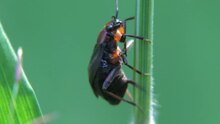Soft bugs
| Soft bugs | ||||||||||||
|---|---|---|---|---|---|---|---|---|---|---|---|---|

Common meadow bug ( Lygus pratensis ) |
||||||||||||
| Systematics | ||||||||||||
|
||||||||||||
| Scientific name | ||||||||||||
| Miridae | ||||||||||||
| Hahn , 1831 |



Soft bugs (Miridae), also known as blind bugs , are a very species-rich family within the suborder Cimicomorpha of bed bugs (Heteroptera). With more than 11,000 species known worldwide to date, they are, alongside the dwarf leafhoppers (Cicadellidae), the only family of hemimetabolic insects with more than 10,000 species and are among the 20 largest insect families at all. It is believed that the family could even include almost 20,000 species in total, especially since many undiscovered species are believed to be in the Neotropic , Oriental and Australasian regions . In Europe they are represented with around 1,200 species and subspecies, in Central Europe there are around 400 species, making the family by far the most species-rich of the bedbugs.
Names
The German name "soft bugs" refers to the slightly hardened (sclerotized) body cover compared to other types of bed bugs. The term “blind bugs”, on the other hand, refers to the predominant lack of point or forehead eyes ( Ocelli ).
features
The soft bugs are small to medium-sized species with a body length of two to 15 millimeters. They vary greatly in their external appearance and color. Many members of this family have an oval, elongated body shape. But there are also very narrow, long or short and clumsy forms. Still other species, such as Myrmecoris gracilis, look very similar to ants . In terms of body color, greenish and brownish-yellow camouflage colors predominate . Black animals are also very common (e.g. genus Capsus ). Conspicuous yellow-black or red-black patterns are less common.
Soft bugs have four-membered antennae . Most species lack pinpoint eyes. Your tarsi have three segments. The front wings ( hemielytras ), which are characteristic of the bedbugs, are comparatively weakly leathery and hardened. In front of the membrane (reduced in some cases) there is a small triangular field (cuneus). This feature sets the soft bugs apart from most other families of bed bugs. The membrane usually has two cells, less often one, at the base. Within some species there is a wing dimorphism .
Way of life
Almost all soft bugs are phytophagous, that is, they feed on plant juices, which they suck by piercing the plants with their stinging-sucking mouthparts. Most of them are monophagous on a certain type of plant or oligophagous on a smaller group of plants. But there are also distinctly polyphagous species that are not very particular about their host plants. Some others, on the other hand, have an exclusively predatory diet, some are mixed foodists, so-called zoophytophages.
The females have a laying sheath with which they dig their eggs more or less deep into soft or lignified host plant tissue. The larvae go through five larval stages separated by moults. Most Central European species overwinter in the egg stage.
Systematics
According to the system used today, eight subfamilies are assigned to the soft bugs. The following are the subfamilies with a selection of species:
- Bryocorinae
- Cylapinae
-
Deraeocorinae
- Red soft bug ( Deraeocoris ruber )
- Isometopinae
- Mirinae
- Two-point meadow bug ( Closterotomus norwegicus )
- Liocoris tripustulatus
- Nordic apple bug ( Lygocoris rugicollis )
- Common meadow bug ( Lygus pratensis )
- Orthops kalmii
- Stenodema laevigata
- Blepharidopterus angulatus
- Cyrtorhinus caricis
- Dryophilocoris flavoquadrimaculatus
- Globiceps fulvicollis
- Halticus luteicollis
- Heterocordylus tibialis
- Heterotoma planicornis
- Malacocoris chlorizans
- Mecomma ambulans
- Orthotylus bilineatus
- Orthotylus flavinervis
- Orthotylus marginalis
- Orthotylus nassatus
- Orthotylus tenellus
- Orthotylus virescens
- Pseudoloxops coccineus
-
Phylinae
- Oak bug ( Harpocera thoracica )
- Psallopinae
meaning
Some species can on the one hand in the agriculture by sucking on plants and the related death of plant parts or the whole plant and malformations as crop pests occur. For a number of species, on the other hand, their suitability as predators of other plant pests is being investigated in biological plant protection.
particularities
The species of the genera Pameridea and Setocoris that are not native to Europe are particularly adapted to life on carnivorous plants .
supporting documents
Individual evidence
- ^ G. Cassis & RT Schuh: Systematics, Biodiversity, Biogeography, and Host Associations of the Miridae (Insecta: Hemiptera: Heteroptera: Cimicomorpha). Annual Reviews of Entomology 2012 57, pp. 377-404. doi: 10.1146 / annurev-ento-121510-133533
- ↑ Family Miridae. (No longer available online.) Australian Biological Resources Study. Australian Faunal Directory, archived from the original on February 8, 2015 ; Retrieved February 8, 2015 . Info: The archive link was inserted automatically and has not yet been checked. Please check the original and archive link according to the instructions and then remove this notice.
- ↑ Miridae. Fauna Europaea, accessed February 8, 2015 .
- ^ Ekkehard Wachmann , Albert Melber, Jürgen Deckert: Bugs. Volume 2: Cimicomorpha: Microphysidae (lichen bugs), Miridae (soft bugs) (= The animal world of Germany and the adjacent parts of the sea according to their characteristics and their way of life . 75th part). Goecke & Evers, Keltern 2006, ISBN 3-931374-57-2 , p. 15 .
- ↑ Frieder Sauer: Sauer's nature guide recognized bugs and cicadas from color photos . Fauna, Keltern 1996, ISBN 3-923010-12-5 , p. 23 .
- ^ RT Schuh, JA Slater: True Bugs of the World (Hemiptera: Heteroptera). Classification and Natural History. Cornell University Press, Ithaca, New York, 1995, pp. 169ff.
literature
- RT Schuh, JA Slater: True Bugs of the World (Hemiptera: Heteroptera). Classification and Natural History. Cornell University Press, Ithaca, New York, 1995.
- Ekkehard Wachmann , Albert Melber, Jürgen Deckert: Bugs. Volume 2: Cimicomorpha: Microphysidae (lichen bugs), Miridae (soft bugs) (= The animal world of Germany and the adjacent parts of the sea according to their characteristics and their way of life . 75th part). Goecke & Evers, Keltern 2006, ISBN 3-931374-57-2 .

